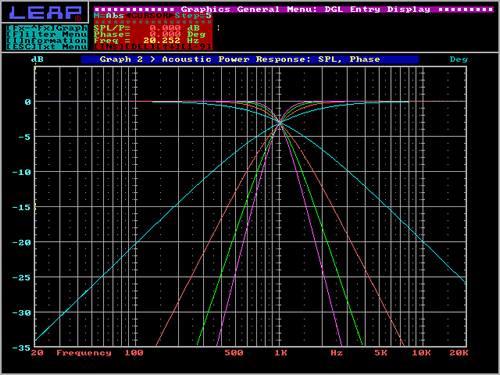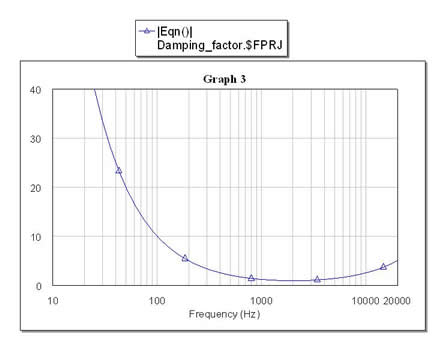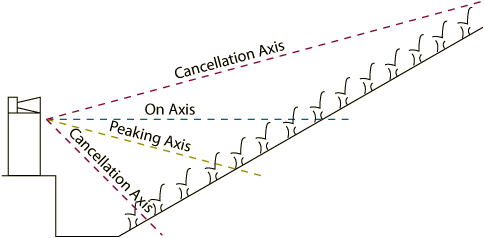- AccurateRip
- Acoustid
- AES/EBU
- AirPlay
- Amplifier
- aptX
- Audio file formats
- ASRC
- AVB
- Bit perfect jitter
- Bits: 16 or 24
- Bit perfect playback
- Bitrate
- Bluetooth
- Burn-in
- BWF
- Cables
- CDtext
- Chromecast
- Clipping
- Clock
- Codec
- Compression
- CRC
- Crossover
- Cue sheet
- DAC
- Damping
- DASH
- Digital
- Digital Room Correction
- Dither
- DLNA
- Drivers
- DoP
- DSP
- EBU R128 (loudness)
- FFT
- FireWire
- Freedb
- Gapless playback
- Generation loss
- HDMI
- Headphone listening
- Hearing
- Hires recording
- Homeplug
- I2S
- ID3
- Inter sample peak
- LDAC
- Linearity (DAC)
- Memory playback
- Music Server
- OCF
- OFC
- PCM
- Perception
- RAID
- ReplayGain
- Ripping
- RFI
- RIAA
- Router
- Sampling, up and over
- Sample Rate Conversion
- Speakers
- S/PDIF
- Storage
- Sync
- Tagging
- Toslink
- Transcoding
- UAA
- Units
- UPnP
- USB
- VST
- WiFi
- WiSA
Crossover
The audible range is 20 - 20.000 Hz.
To reproduce music correctly, a speaker must be able to reproduce this range.
To reproduce bass, you need a speaker moving a substantial amount of air at a low pace.
So big and strong and therefore heavy.
To reproduce high frequencies, it must move very fast so it must be light and small.
It is difficult combine these requirements in one speaker but they do exist, the full range driver.
It is practically impossible for a single radiator to cover the 20 Hz to 20 kHz audio frequency range at adequate sound pressure levels (SPL) and with wide dispersion off-axis. At a 50 Hz bass frequency, for example, it takes an air volume displacement of 214 cm3 to generate 90 dB SPL at 1 m distance from the source in free space. Take a typical 6.5 inch (132 mm effective) diameter driver and its cone would have to move 14 mm peak-to-peak linearly, which by far exceeds its excursion capability.
At 1000 Hz, though, the same driver would have to vibrate only with (50/1000)2 = 1/400th of this excursion for the same 90 dB SPL.
In practice many systems are 2-way, one big, strong and heavy driver for the bass (woofer) and a small and light one for the mid/high range (tweeter).
Feed high frequencies into the woofer and it probably will produce some distorted sound and heat up a little.
Feed the bass signal into the tweeter and it will burn.
You need two filters, a low pass for the bass and a high pass for the tweeter to protect them against frequencies they can’t reproduce.
As the bass filter falls off, the filter for the tweeter comes into play so somewhere these two filters slopes cross. In other words, a crossover.
Crossover with 6,12,18 and 24 dB per octave rolloff
Slope
Crossovers are characterized by their slope
First order has a gentle 6 dB/octave slope.
This filter type is 'transient perfect', it passes both amplitude and phase unchanged but at the expense of a large overlap between the two drivers.
This might force both woofer and tweeter to reproduces frequencies outside their sweet spot.
The answer is use the steeper slopes to reduce the overlap.
Second order filters drops with 12 dB/octave, third with 18 and fourth with 24.
As usual in technology, the law of the conservation of problems comes into play.
With increasing order, the complexity increases too.
The filters become more complex and create artifacts like lobing and other unwelcome off-axis effects, pre-ringing, etc.
Demo

Paul Falstad wrote an applet demonstrating how different filters affect the spectrum and the impulse response using various signals.
Implementation
There are three ways to implement a crossover.
- Passive: crossover between power amp and drivers. This requires a amp (mono) per box.
- Active: crossover between pre-amp and power amp. This requires an amp per driver.
- DSP: using a processor to calculate the appropriate value in real-time for each channel. This requires a DAC+ amp per driver.
Passive crossovers
This is a common type of crossover in home and high-end audio.
It is a simple and cost-effective solution although real high quality passive crossovers can be quite expensive.
The biggest saving is that you only need one amp per channel (speaker) in contrast to active crossovers where you need an amp per driver.
As the crossover is between the amp and the drivers, it must be able to handle power of the amp. This can only be done by using simple passive and reactive components like resistors, capacitors and inductors (coil).
A famous one, the 4th order like Linkwitz-Riley, very common in the pro-world, is almost impossible to implement properly with these components due to the tight tolerances needed.
This type of crossover had better be implemented using active components.
2nd order passive crossover network with a crossover frequency of 2 kHz
The graph displays the effective damping factor when the crossover network is in circuit
At 30Hz, the damping factor is a just about tolerable 34, but it drops sharply as the frequency is increased, dropping to less than 2 right from 500Hz to over 7kHz. At the 2 kHz crossover frequency the damping factor is just 1!
So what does this mean?
The results show that a typical passive crossover has an absolutely disastrous effect on speaker damping. Over most of the audio band, the damping factor is very low, so the amplifier will have almost no control over the cone movement at all. Were it not for the mechanical self damping in the drive unit suspension, the cone would be flapping around wildly. As it is, the cone movement will certainly not be accurately following the applied signal voltage from the amplifier.
What about active crossovers?
With an active speaker, the crossover network is connected at the amplifier inputs, and the amplifier outputs drive the speaker drive units directly. In this case, the excellent damping factor of the amplifiers is maintained, and the cone motion is accurately controlled at all frequencies. In the past, the main argument against the active speaker approach has been the cost. But these days, power transistors are cheap, so there really is no excuse!
Active crossover
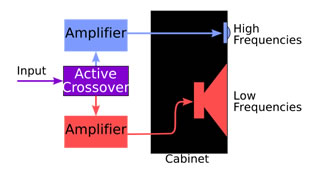 An active crossover gets its input from the pre-amp and sends the signal to multiple outputs, each connected to a power amp.
An active crossover gets its input from the pre-amp and sends the signal to multiple outputs, each connected to a power amp.
Each power amp drives only one driver.
As the passive crossover is removed out of the power circuit, the amp has now full control over the driver (damping).
The crossover is working on line level. This allows the use of active components (opamps).
This allows for more functionality than possible with passive components:
- Different filters like Butterworth, Bessel and Linkwitz-Riley
- Selectable roll-off characteristics from 6 to 48 dB/octave
- Parametric Equalization
- Time Alignment of transducers
- System Gain
- Individual output channel gain
- Etc.
According to ATC, a pioneer in active design, the benefits are:
1. The magnitude of the frequency response of both active and passive loudspeakers can be controlled, with good design, to
be within 1dB of one another. However, the phase component of
the frequency response will always be better in an active system.
The active filters produce better filter roll-off characteristics at
crossover. Combine this with the inclusion of a variable all-pass
filter at each crossover point to correct the phase response of the drive units through the crossover regions and the result is
a loudspeaker with much better group delay characteristics.
The benefit to the listener will be improved polar response and
therefore radiated power response. Such an active loudspeaker
will, therefore, have a large stable sound field with stable imaging
and source location not possible with a passive loudspeaker.
2. A passive crossover will only operate correctly into the
load impedance of a particular loudspeaker drive unit. However,
the impedance of a loudspeaker drive unit will change with the amount of power input. This is because loudspeakers are very
inefficient and most of the input power is dissipated as heat in
the voice coil. As a result the temperature of the voice coil will rise and, because copper has a positive temperature coefficient
of resistance, the impedance of the loudspeaker drive unit will
rise. The result will be frequency response errors as the filters move from their designed response with
increased input power. This effect does not occur in active loudspeakers where
the filter response is maintained
independent of input power to the
loudspeaker.
3. Because the amplifiers in an active loudspeaker system are only required to operate over reduced frequency bands the intermodulation distortion products present in a passive system will be dramatically reduced, by typically 20dB, in an active system.
4. In an active system the absence of a passive crossover and
long cable runs together with a known amplifier damping factor
prevents the modification of the loudspeaker drive unit “Q” ensuring better controlled low frequency performance.
5. For a given amount of amplifier power an active loudspeaker
can be expected to produce approximately 6dB more
level than the equivalent passive system. Furthermore, powers may be more optimally specified in an active system. A tweeter,
for example, requires much less power than a woofer to produce
a balanced system performance.
Source: ATC
Active crossovers can be bought separately but most of the time they are integral part of active speakers.
A very common active crossover is the 4th order Linkwitz-Riley.
The benefits are:
- Absolutely flat amplitude response throughout the passband with a steep 24 dB/octave rolloff rate after the crossover point.
- The acoustic sum of the two driver responses is unity at crossover. (Amplitude response of each is -6 dB at crossover, i.e., there is no peaking in the summed acoustic output.)
- Zero phase difference between drivers at crossover. (Lobing error equals zero, i.e., no tilt to the polar radiation pattern.) In addition, the phase difference of zero degrees through crossover places the lobe of the summed acoustic output on axis at all frequencies.
- The low pass and high pass outputs are everywhere in phase. (This guarantees symmetry of the polar response about the crossover point.)
Source: Rane Corporation
Butterworth all-pass crossover stage-audience relationship
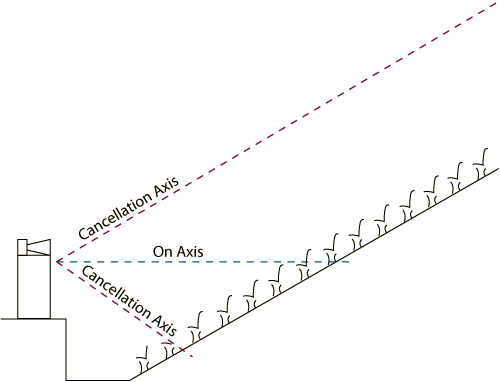
Linkwitz-Riley crossover stage-audience relationship
Linkwitz-Riley is probably the summit of analogue crossover design.
At the same time it might be its swan song too as today all this and much more can be done using DSP.
DSP
DSP is Digital Signal Processing.
It can be used for the crossover, correcting the frequency response, room correction, etc.
It eliminates a bunch of components.
All the processing is done in real time.
As DSP is a matter of programming, traditional crossovers (known as IIR (Infinite Impulse Response) like Bessel, Butterworth, Linkwitz-Riley etc.) can be modelled.
An alternative is to use FIR filters (Finite Impulse Response).
FIR filters allow for higher order and can have a linear phase response.
Often DSP is also used to correct the frequency response.
Normally this is ± 3 dB. With DSP this can be reduced to ± 0.5 dB.
However, our hearing is not very sensitive to this type of fluctuations.
Room correction, placement correction are additional options.
If you feed the box an analog signal, it has to be converted to digital before DSP can be applied.
So you spend a fortune on a DAC only to have its analog out converted to digital again.
The output of the DSP has to be converted to analog again by DACs before it can be sent to the amp.
Sample rate
Most manufacturers are pretty frugal on the specs but don’t be surprised if the DSP is done at 48 kHz.
If you feed the box 44.1 kHz it will be resampled to 48 kHz
The same applies to your hi-res recordings….
Examples of active crossovers can be found here.
Put the amps and the active crossover in a speaker and you have an active speaker.
- Audio crossover - Wikipedia
- X-overs - Lenard Audio
- Demonstration of digital filters - Paul Falstad


